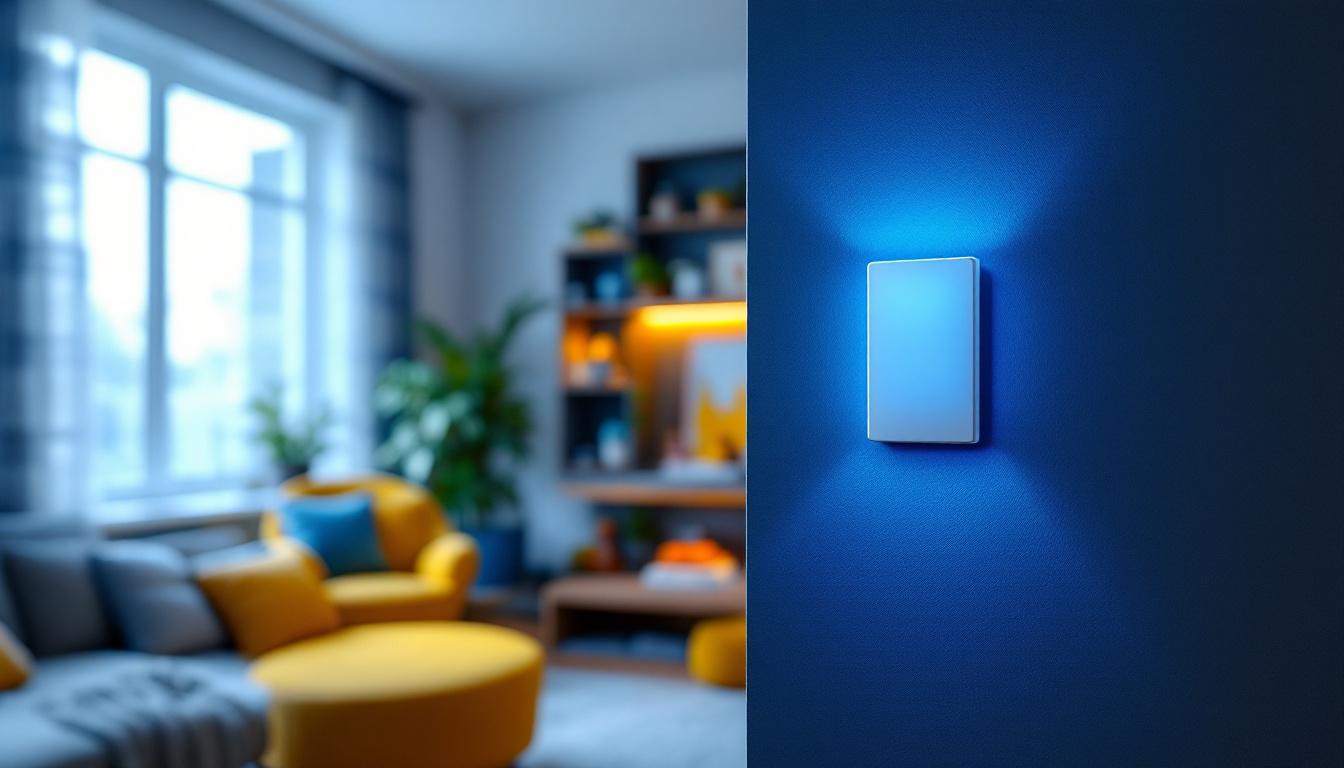
As the demand for energy-efficient lighting solutions continues to grow, LED light switches have become an essential component in modern electrical installations. For lighting contractors, understanding the nuances of LED technology and its associated switches is crucial for delivering quality service to clients. This article provides an in-depth look at LED light switches, offering valuable advice to lighting contractors on how to effectively integrate them into their projects.
Before diving into the specifics of LED light switches, it is important for contractors to have a solid grasp of LED technology. LEDs, or Light Emitting Diodes, are semiconductor devices that convert electrical energy directly into light. This technology has revolutionized the lighting industry due to its numerous advantages over traditional incandescent and fluorescent bulbs.
LED lighting offers several benefits that make it a preferred choice for both residential and commercial applications. Firstly, LEDs are highly energy-efficient, consuming significantly less power than their incandescent counterparts. This efficiency translates into lower electricity bills for clients and a reduced carbon footprint.
Furthermore, LEDs have a longer lifespan, often lasting up to 25,000 hours or more. This longevity reduces the frequency of replacements, leading to lower maintenance costs over time. Additionally, LEDs emit less heat, which can contribute to a more comfortable environment and lower cooling costs in spaces where lighting is used extensively. This is particularly beneficial in commercial settings, where lighting is often on for extended periods, thus maximizing energy savings and enhancing overall operational efficiency.
Another important aspect of LED technology is the range of color temperatures available. LEDs can produce a variety of hues, from warm white to cool daylight, allowing contractors to tailor lighting solutions to the specific needs of each space. Understanding the desired ambiance and functionality of a room is essential when selecting the appropriate LED color temperature. For instance, warm white light is ideal for creating cozy atmospheres in living rooms and bedrooms, while cooler temperatures are often preferred in workspaces and kitchens to enhance focus and productivity.
Moreover, the quality of light produced by LEDs is often superior to that of traditional bulbs. With advancements in LED technology, the color rendering index (CRI) has improved, making it possible to achieve vibrant and true-to-life colors in any setting. High CRI LEDs can significantly enhance the visual appeal of retail displays, art galleries, and even residential interiors, allowing colors to appear more vivid and attractive. This capability not only elevates the aesthetic quality of a space but also plays a crucial role in influencing consumer behavior in commercial environments, where lighting can enhance product visibility and desirability.
When it comes to controlling LED lighting, the type of switch used can significantly impact performance and user experience. Various types of LED light switches are available, each with its own set of features and benefits. Familiarity with these options allows contractors to recommend the best solutions for their clients.
Standard toggle switches are the most common type of light switch used in residential and commercial settings. They are simple to operate and can be easily installed. However, when using standard toggle switches with LED fixtures, it is essential to ensure compatibility. Some older toggle switches may not work effectively with LED lights, leading to flickering or buzzing.
To avoid these issues, it is advisable to use toggle switches specifically designed for LED applications. These switches are engineered to handle the lower wattage and unique electrical characteristics of LED lighting, ensuring smooth operation without flicker. Additionally, many modern toggle switches come with a sleek design that can enhance the aesthetic of any room, making them not just functional but also visually appealing.
Dimming capabilities are a significant advantage of LED lighting, allowing users to adjust brightness levels according to their preferences. However, not all dimmers are compatible with LED lights. Contractors should recommend dimmers that are explicitly labeled as “LED compatible” to ensure optimal performance.
LED dimmers work by using advanced technology to manage the electrical load, providing a smooth dimming experience without flickering. It’s essential to educate clients on the benefits of using compatible dimmers, as they can enhance the overall lighting experience and extend the lifespan of the LEDs. In addition to functionality, many LED dimmers offer customizable features, such as preset brightness levels and remote control options, allowing users to create the perfect ambiance for any occasion, from a cozy movie night to a vibrant dinner party.
The rise of smart home technology has introduced a new category of LED light switches: smart switches. These switches allow users to control their lighting remotely via smartphones or voice assistants. They offer features such as scheduling, scene setting, and energy monitoring, making them an attractive option for tech-savvy clients.
Lighting contractors should familiarize themselves with various smart switch options and their compatibility with different LED systems. Providing clients with information about the benefits of smart lighting can help them make informed decisions and enhance their overall satisfaction with the lighting installation. Furthermore, many smart switches integrate seamlessly with existing home automation systems, allowing for a cohesive smart home experience. This integration can lead to energy savings, as users can program their lights to turn off when they leave the house or dim automatically during certain times of the day, contributing to both convenience and efficiency in energy consumption.
Proper installation of LED light switches is crucial for ensuring optimal performance and longevity. Lighting contractors should adhere to best practices to avoid common pitfalls and deliver high-quality installations.
One of the first considerations when installing LED light switches is understanding the electrical load. LED lights typically draw less power than traditional bulbs, which can affect how switches are wired. It is essential to ensure that the switch is rated for the specific load of the LED fixtures being used.
Contractors should also be aware of the total wattage of the LED fixtures connected to a single switch. Exceeding the switch’s wattage rating can lead to overheating and potential failure. Properly calculating and managing the electrical load will help prevent issues down the line. Furthermore, it’s beneficial to consider the dimming capabilities of the LED fixtures in conjunction with the switch, as not all switches are designed to handle dimmable LEDs. This compatibility is vital for achieving the desired ambiance and functionality in a space.
Wiring is another critical aspect of LED light switch installation. Contractors should follow local electrical codes and regulations to ensure safety and compliance. It is advisable to use high-quality wiring that can handle the demands of LED lighting systems.
Additionally, when retrofitting existing lighting systems with LED fixtures and switches, careful attention should be paid to the existing wiring. In some cases, upgrading the wiring may be necessary to accommodate the lower wattage and unique characteristics of LEDs. It is also important to consider the length of the wiring runs; longer distances may require thicker gauge wire to prevent voltage drop, which can affect the performance of the LED lights. Ensuring that all wiring is properly insulated and secured will help maintain safety and efficiency in the installation.
After installation, thorough testing is essential to ensure that all components are functioning correctly. Contractors should check for flickering, buzzing, or any other irregularities that may indicate compatibility issues between the LED fixtures and switches.
If problems arise, troubleshooting should begin with verifying the compatibility of the switch with the LED lights. In some cases, replacing a standard switch with an LED-compatible model may resolve the issue. Additionally, ensuring that all connections are secure and properly wired can help eliminate potential problems. It’s also advisable to conduct a load test after installation to confirm that the system operates within safe limits. This proactive approach can identify potential issues before they escalate, ensuring a reliable and efficient lighting solution for the end user. Regular maintenance checks can also be beneficial in prolonging the lifespan of the installation and ensuring continued performance over time.
Educating clients about LED light switches and their benefits is an important aspect of a contractor’s role. Providing clear information can help clients make informed decisions and enhance their overall satisfaction with the lighting solutions provided.
Clients are often concerned about energy costs, making it essential to explain the energy efficiency of LED lighting and switches. Highlighting the potential savings on electricity bills can help clients appreciate the long-term benefits of investing in LED technology.
Additionally, discussing the environmental impact of using energy-efficient lighting can resonate with clients who prioritize sustainability. Providing data or case studies that illustrate the energy savings achieved through LED installations can further reinforce the advantages of these solutions.
Proper maintenance is key to ensuring the longevity of LED lighting systems. Contractors should advise clients on how to care for their LED fixtures and switches, including the importance of keeping them clean and free of dust.
Furthermore, educating clients about the signs of potential issues, such as flickering or dimming, can empower them to seek assistance promptly. Offering ongoing support and being available for questions can help build trust and foster long-term relationships with clients.
LED light switches are an integral part of modern lighting installations, offering energy efficiency, versatility, and enhanced control. For lighting contractors, understanding the various types of switches, installation best practices, and the importance of client education is essential for delivering high-quality service.
By staying informed about the latest advancements in LED technology and providing clients with the knowledge they need to make informed decisions, contractors can position themselves as trusted experts in the field. Embracing the shift towards LED lighting not only benefits clients but also contributes to a more sustainable future for the lighting industry.
Ready to elevate your lighting projects with the best LED light switches on the market? Look no further than LumenWholesale, where we provide lighting contractors with superior, spec-grade lighting products at unbeatable wholesale prices. Say goodbye to local distributor markups and hello to our extensive selection that meets the highest industry standards. With LumenWholesale, you can count on reliable, high-performance lighting for every project. Plus, enjoy the convenience of bulk buying with free shipping, ensuring you get premium lighting at the best value — without hidden fees or compromises. Wholesale Lighting at the Best Value is just a click away. Upgrade your lighting solutions with LumenWholesale today and experience the perfect blend of quality, affordability, and convenience.

Discover essential insights for lighting contractors in this comprehensive guide on light bulbs and LED tubes.

Discover the ultimate guide to light bulb bases with insights from expert lighting contractors.

Discover the art of interior lighting with expert insights for lighting contractors.

Discover essential strategies and expert tips for lighting contractors in “Light Up Church.” This guide delves into innovative techniques and best practices to illuminate sacred spaces, enhancing both aesthetics and spiritual ambiance.